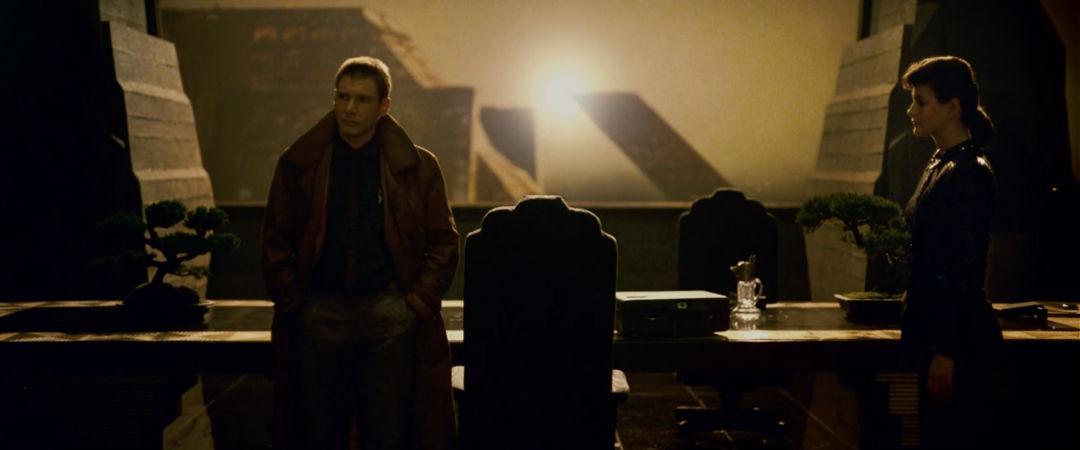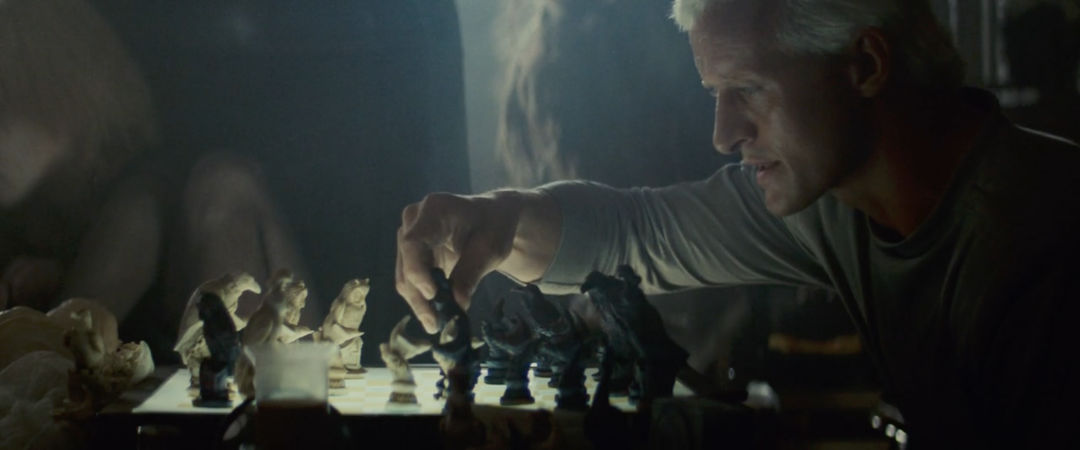Blade Runner

Tyrell's office at sunset
Blade Runner was a film directed by Ridley Scott, released in 1982. It's a rough adaptation of Philip K. Dick's novel Do Androids Dream of Electric Sheep?
It has a similar aesthetic to Scott's other films of the era, such as Alien and Legend. (Note the excellent use of backlit smoke.) While the very American plot about a police officer hunting freed slaves is abhorrent, it's one of the most beautiful and atmospheric films of all time, from the glow of neon signs in rain through to the Vangelis soundtrack.

J. F. Sebastian's chess set
It has everything you could hope for visually: a seemingly endless night; damp, reflective streets; backlit silhouettes; pockets of light and movement, including conspicuously off-kilter CRTs, shimmering reflections, and animated billboards; the Bradbury Building's atrium; Ennis House, along with an interior set made with matching replica tiles; the 2nd Street Tunnel; and vehicles and other technology designed by Syd Mead. But mostly the rain, smoke, and lighting, from candles to endless neon signs. Every shot oozes atmosphere. The night, rain, and smoke may have been used to hide the film's limitations,[1] but these workarounds work very much in its favour.
Much like the rooftop set dressing, I'm a big fan.
Legacy
Blade Runner had many of the same influences as William Gibson's Neuromancer,[2] a seminal work in the cyberpunk genre. Chiefly, both were influenced by "The Long Tomorrow", written by Dan O'Bannon (who also wrote the screenplay for Ridley Scott's Alien) and illustrated by Moebius.
At the time of its release, Blade Runner was overshadowed by E.T.,[3][1][4] technically also a science fiction film, albeit aimed at a very different audience. However, Blade Runner was highly influential.
Its aesthetic has been imitated in music videos,[1] fashion, nightclubs,[2] and video games. (For example, Sonic the Hedgehog's Scrap Brain Zone mimics both its industrial landscape and end theme.)
To modernise the backlot's existing buildings, the film crew had retrofitted futuristic infrastructure on top of them. What they'd done out of necessity then influenced real life architects, who started to show their buildings' infrastructure on the outside.[1][2]
It's among the most sampled films of all time.[5] Pete Namlook in particular was especially partial to sampling its dialogue.
Quotes
The reason why I could not have done those sets in daylight, it wouldn't have looked good. It would have looked pretty bad, and we would have had to spend more money. So by shooting at night, you save money. And it looks better. And it's always raining. It looks better. That's what it's about. And why is there always smoke? Because I haven't got enough money. It looks better. So those three elements are always my armoury: night; wet; smoke.
— Ridley Scott, 2007[1]
I was afraid to watch Blade Runner in the theater because I was afraid the movie would be better than what I myself had been able to imagine. In a way, I was right to be afraid, because even the first few minutes were better. Later, I noticed that it was a total box-office flop, in first theatrical release. That worried me, too. I thought, Uh-oh. He got it right and nobody cares! Over a few years, though, I started to see that in some weird way it was the most influential film of my lifetime, up to that point. It affected the way people dressed, it affected the way people decorated nightclubs. Architects started building office buildings that you could tell they had seen in Blade Runner. It had had an astonishingly broad aesthetic impact on the world.
I met Ridley Scott years later, maybe a decade or more after Blade Runner was released. I told him what Neuromancer was made of, and he had basically the same list of ingredients for Blade Runner. One of the most powerful ingredients was French adult comic books and their particular brand of Orientalia — the sort of thing that Heavy Metal magazine began translating in the United States.
But the simplest and most radical thing that Ridley Scott did in Blade Runner was to put urban archaeology in every frame. It hadn't been obvious to mainstream American science fiction that cities are like compost heaps — just layers and layers of stuff. In cities, the past and the present and the future can all be totally adjacent. In Europe, that's just life — it's not science fiction, it's not fantasy. But in American science fiction, the city in the future was always brand-new, every square inch of it.
— William Gibson, 2011[2]
For me, the origin of the aesthetic of something like The Matrix really starts with Blade Runner, which was a very urban, gritty, high-contrast, very moody light... there was another movie that came out the same year, that was called ET. ET was done in this very dominant aesthetic of the day. It was a very soft, glowy light. The contrast was very low. It was very filtered light. There was an innocence to the style. Ridley Scott was more interested in this aesthetic that came out of noir... this very aggressive, dark aesthetic. And he took it and he applied it to science fiction. Everyone hated Blade Runner when it came out. It was a universally despised movie... I would just argue with my friends, who just worshipped ET.
— Lana Wachowski, 2013[4]
See also
References
- Dangerous Days Charles de Lauzirika, 2007
- "William Gibson, The Art of Fiction № 211" David Wallace-Wells, The Paris Review, 2011
- Future Noir: The Making of Blade Runner Paul M. Sammon, 1996, ISBN 0-75280-740-4, pp. 316—317
- "The Wachowskis" DePaul Visiting Artists Series, Nov 2013
- "The Top 1319 Sample Sources, Version 60" Peter Cigéhn, Sep 2004
Further reading
Retrospectives
- Future Noir: The Making of Blade Runner Paul M. Sammon, 1996, ISBN 0-75280-740-4
- Dangerous Days Charles de Lauzirika, 2007
- Typeset in the Future Dave Addey, 2018, ISBN 978-1-4197-2714-6, pp. 118—143
Cyberpunk: Blade Runner
Films: Blade Runner

